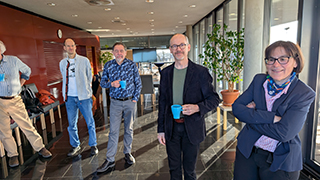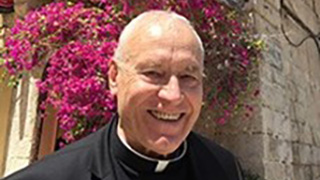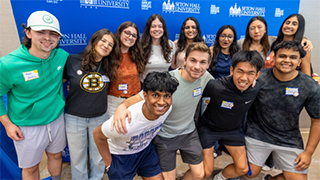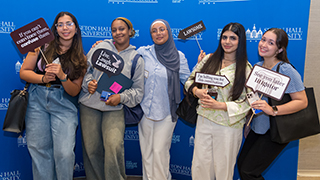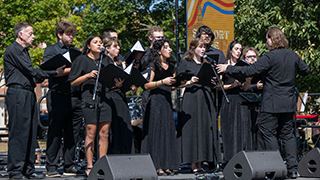Teaching and Learning in Changing Times
Thursday, April 16, 2020

"The kids like being able to pace themselves and take as much time as they need to stay on track with their peers," says senior Claudia Valverde, who is a biology student teacher at West Orange High School.
When he began student teaching last fall, Tyler Kauth, an elementary and special education major, never imagined that he'd be hosting virtual office hours for his third graders. But Zoom chats are now part of Kauth's daily routine and one of the best tools he has for keeping up with students who are learning from home. Fellow senior Erin Murphy, whose classroom at the Orange Avenue School in Cranford was next to Kauth's, says that teaching and learning during the Covid-19 pandemic has been an adjustment. "Without seeing their faces," she says, "it's hard to know if they are following along." Email messages and on online class meetings are helping Murphy stay connected with her class.
As student teachers Murphy and Kauth are part of the clinical practitioner program at the College of Education and Human Services. As they did in their classrooms, these young educators continue to support their cooperating teachers and students while adapting to new ways of learning together. "This is how life is going to be right now," says Karen Grove, a former teacher who now directs the office of Clinical Experiences and Applied Research at the College of Education and Human Services. "We have to accept it and work to find the best ways to support our candidates, their cooperating teachers and all of the K-12 students in their classrooms."
Students' experience with home schooling varies from district to district depending on how online learning is set up. At West Orange High School, which is one of several schools partnering with Seton Hall, students have flexible schedules and optional early morning check-ins. They can submit assignments as late as midnight. "The kids like being able to pace themselves and take as much time as they need to stay on track with their peers," says senior Claudia Valverde. Fellow biology teacher Veronica Harrison, has seen the work of some of her students flourish. "I feel like they're able to get up at a decent hour and are getting more rest. Because they are managing their schedule for the day, their content is improving. Their thought process is more complete."
To better understand how her students felt about their new routines, Valverde invited her biology students to take an online survey she set up. Some reported being happy with the schedule while others said they were tempted to procrastinate. Valverde encourages her students to come with schedules that work best for them. Some students did not have access to WiFi when the shift to learning online began, as local internet service providers hurried to provide service to households that needed it. Rather than penalizing them for minor infractions Valverde believes it's important to be understanding about what her students are going through and give them time and space to figure things out.
Prepared for Change
A state-wide school shut down was never on the list of what teachers needed to anticipate,
however, Seton Hall's student teachers know a lot about keeping kids busy throughout
the day. Gabrielle Van Tassell, a student teacher assigned to a kindergarten class
in South Orange, says she's drawn on class management planning techniques and finding
ways to build "fun things that kids like," into her lesson plans. Frequently referred
to as "digital natives" education undergraduates take courses that prepare them to
use technology in the classroom. They've gone on virtual museum tours, created web
sites and donned virtual reality headsets to ready themselves for the 21st century
classroom. "I do handle a lot of the tech stuff," says Van Tassell who has been an
advocate for using technology in her classroom. "I feel comfortable with it."
As the stay-at-home order restricts students to learning from home, student teachers provide the moral and practical support their cooperating teachers and students need right now. They sort through homework and read books aloud from their living rooms. Gabrielle, a member of the Seton Hall swim team, created a science lesson for her kindergarten class titled, Float or Sink. To make sure students stay engaged in typical learning activities they have in the classroom, she recorded herself reading "Three Billy Goats Gruff," a class favorite.
As they have always done, student teachers answer questions throughout the day. Some are impossible to answer right now, such as when school will start again. They care about their students and engage with them holistically. One of Murphy's elementary students writes to her daily. She worries about her mom, a nurse who takes care of patients who are battling the coronavirus. "It's heartbreaking to read," she says. "I try to remind her how much those patients appreciate that people like her mom who are there to help. I reassure her that her mom will wash her hands and do all she can to stay safe."
Grove collects feedback from her education students and shares what she learns with administrators at partners schools. Grateful for their insights, she says students are better prepared for teaching as a result of what's going on. "They're taking care of themselves and their students," ensuring that learning continues, no matter how different it may look right now.
Educational Studies
The Educational Studies Department provides undergraduate teacher preparation programs in early childhood, elementary
education, and special education as well as secondary education. At the graduate level,
the department has programs in initial teaching certification, professional development
for educators, instructional technology, and media specialist.
Categories: Education


